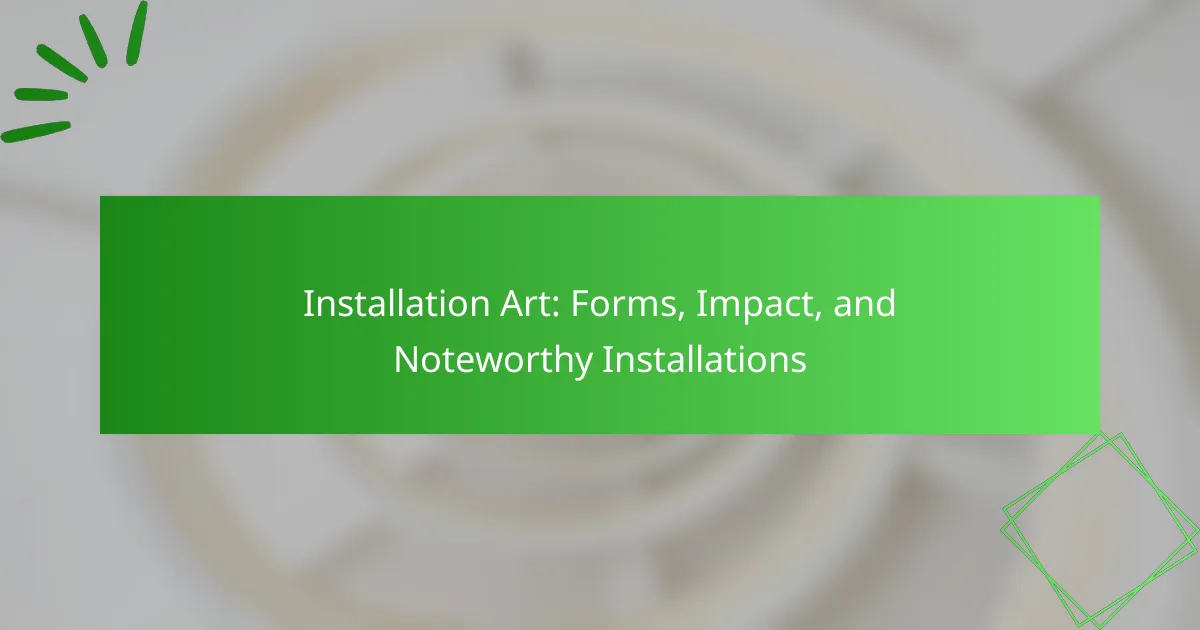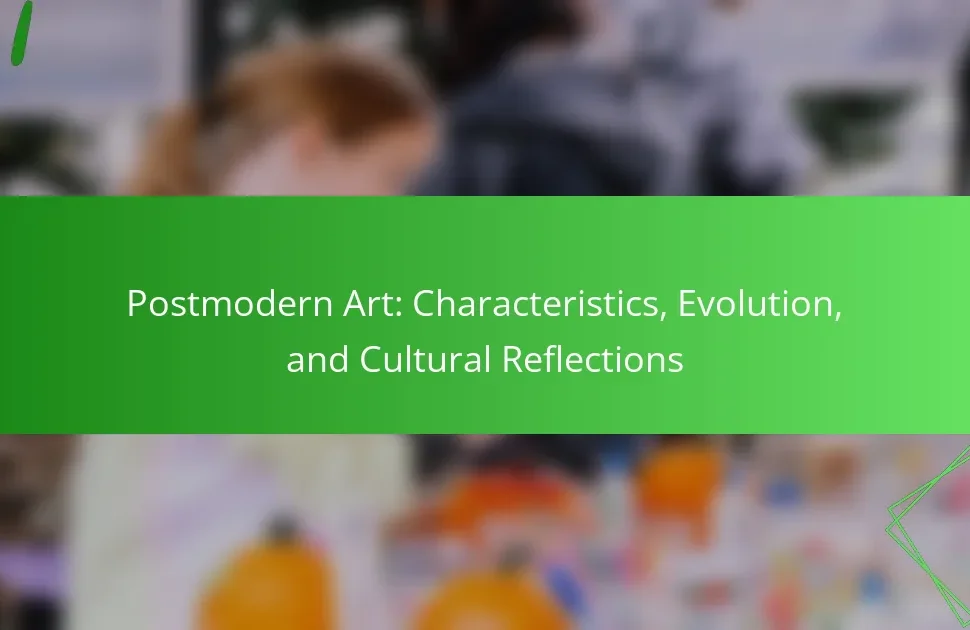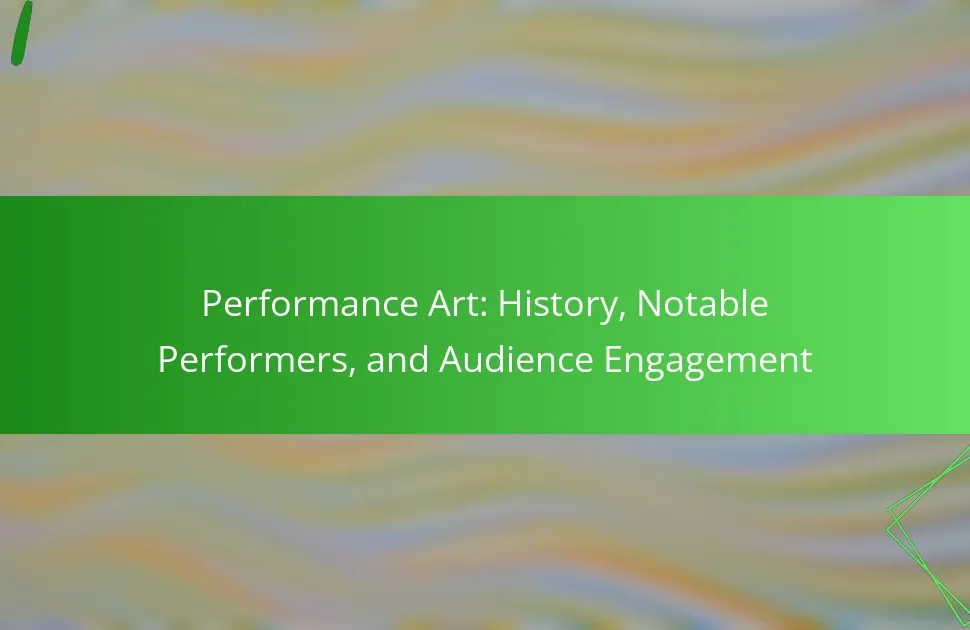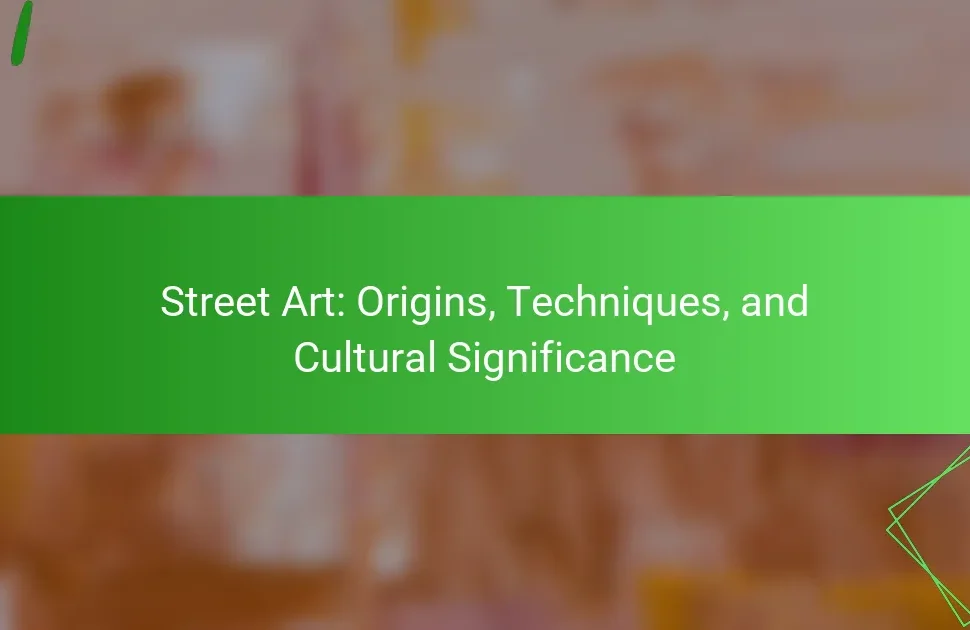Installation art engages viewers through immersive, multi-sensory experiences that transform spaces. This article explores popular forms, significant cultural impacts, and notable installations by artists like Olafur Eliasson and Yayoi Kusama. It also examines the challenges faced by installation artists and emerging trends in the field.
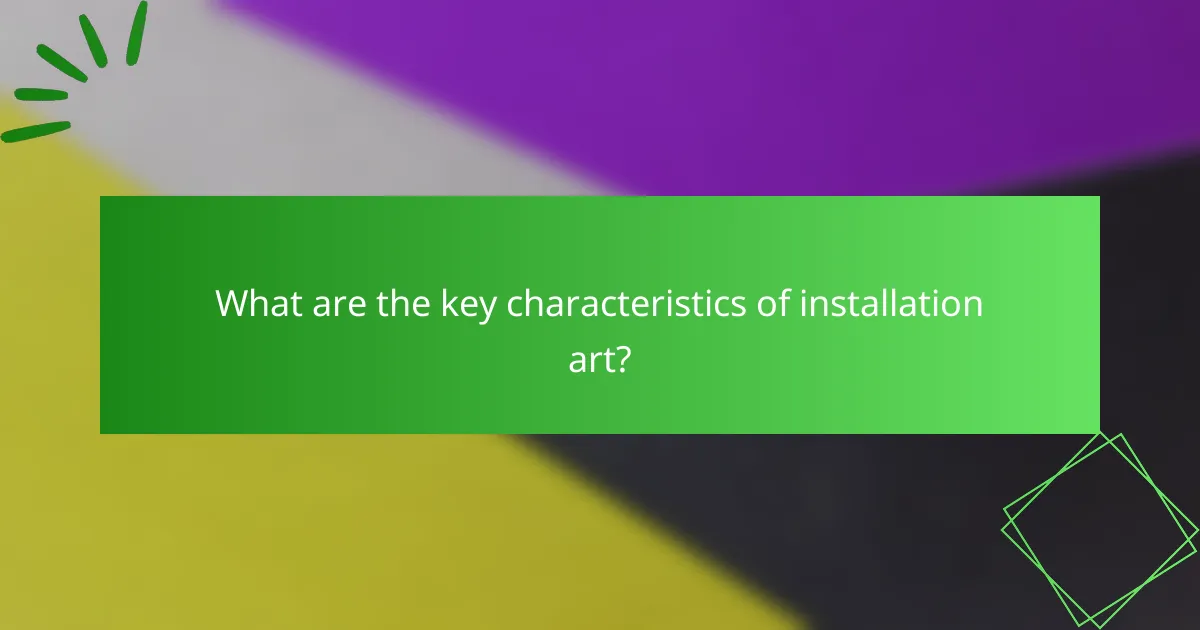
What are the key characteristics of installation art?
Installation art is characterized by its immersive, site-specific nature, engaging viewers through a multi-sensory experience. Key characteristics include interactivity, the use of diverse materials, and the ability to transform space. Noteworthy installations often challenge perceptions of art and environment, using elements like sound, light, and movement to create dynamic experiences. Unique attributes of installation art can include temporary displays that provoke emotional responses and encourage viewer participation.
How does installation art differ from traditional art forms?
Installation art engages viewers in immersive experiences, contrasting with traditional art forms that typically focus on static displays. Unlike paintings or sculptures, installation art often incorporates various media and environments, inviting interaction. This form emphasizes viewer participation, altering perceptions of space and context. Noteworthy installations, such as Christo and Jeanne-Claude’s “The Gates,” showcase how installation art can transform public spaces, creating temporary yet impactful experiences.
What role does space play in installation art?
Space plays a crucial role in installation art by shaping the viewer’s experience and interaction. The physical environment influences how the artwork is perceived, often transforming ordinary spaces into immersive experiences. Unique attributes like scale and layout can evoke emotional responses, while the integration of light and sound enhances the overall impact. Noteworthy installations often utilize unconventional spaces, emphasizing the relationship between art and architecture. This dynamic interaction creates a dialogue between the artwork and its surroundings, making space an essential element in the effectiveness of installation art.
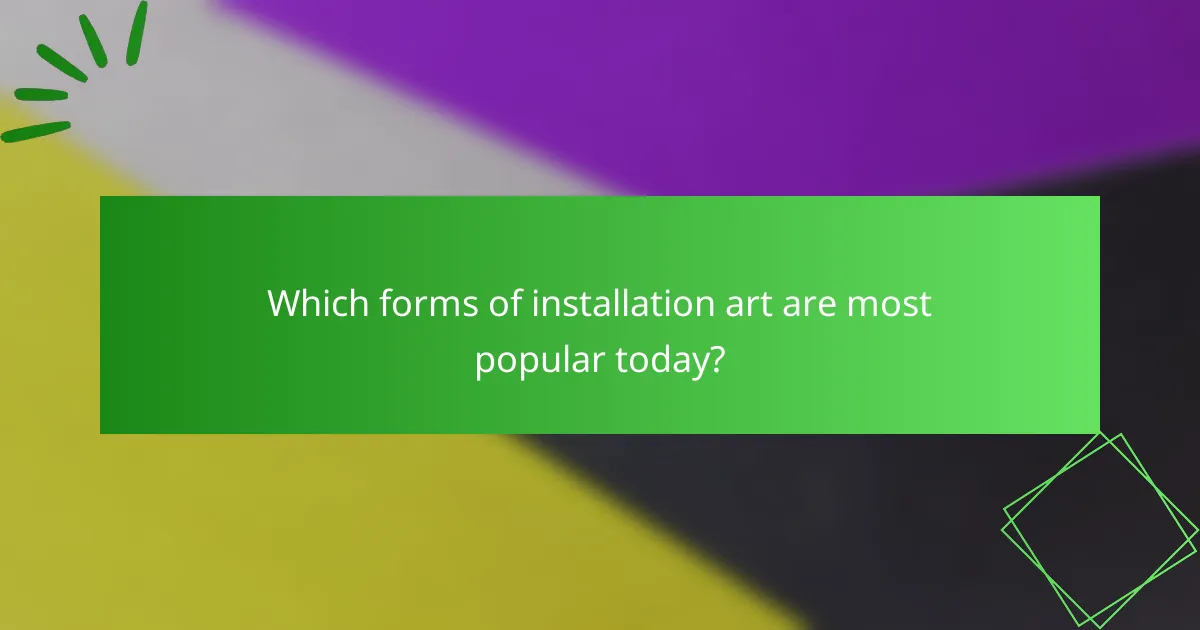
Which forms of installation art are most popular today?
The most popular forms of installation art today include immersive environments, site-specific installations, and interactive pieces. Immersive environments engage viewers through sensory experiences, often using sound and light. Site-specific installations transform locations, creating a dialogue between art and space. Interactive pieces invite audience participation, blurring the line between creator and observer. Each form reflects contemporary themes and engages diverse audiences.
How do immersive installations engage audiences?
Immersive installations engage audiences by creating interactive experiences that stimulate multiple senses. These installations often incorporate technology, sound, and visual elements to foster emotional connections. As a result, participants actively engage rather than passively observe. Noteworthy examples include teamLab Borderless, which merges art and technology to create a dynamic environment. Such experiences encourage exploration and personal interpretation, enhancing the overall impact of installation art.
What are the benefits of interactive installations?
Interactive installations enhance audience engagement, encourage exploration, and foster creativity. They create immersive experiences that stimulate emotional responses and promote social interaction. Additionally, they often incorporate technology, providing innovative ways to convey messages and art concepts. These installations can transform public spaces, making art accessible and relevant to diverse audiences.
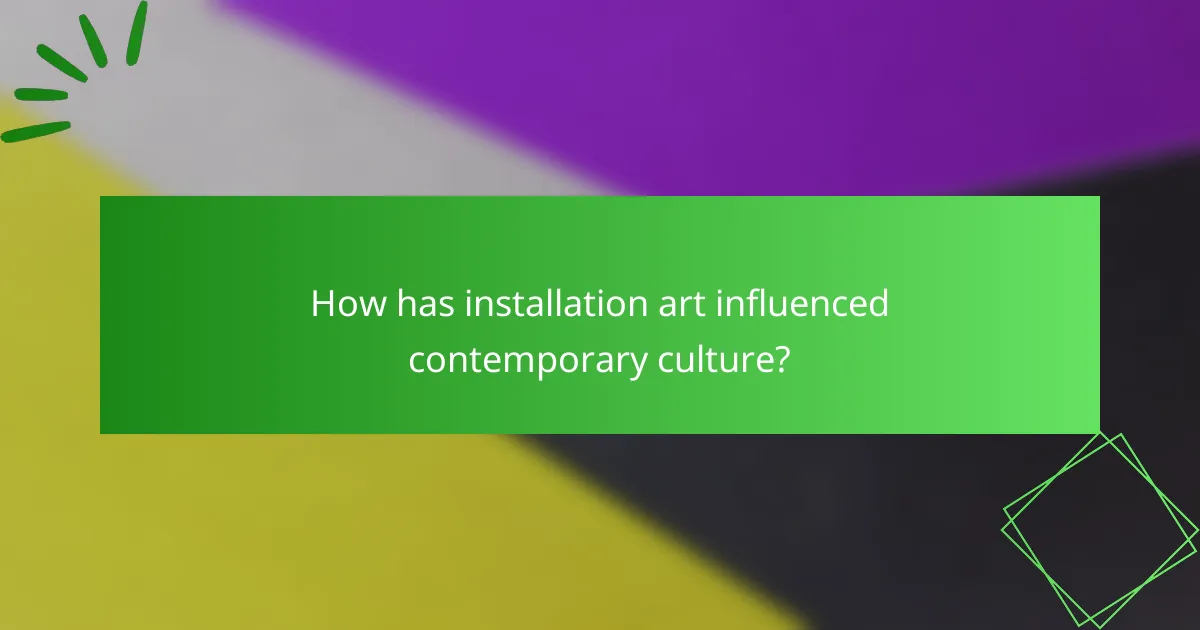
How has installation art influenced contemporary culture?
Installation art has significantly influenced contemporary culture by reshaping perceptions of space and viewer interaction. This art form encourages immersive experiences, fostering emotional engagement and critical dialogue. Noteworthy installations, such as Christo and Jeanne-Claude’s “The Gates,” have transformed public spaces, prompting discussions on environmental and social issues. As a result, installation art has become a vital medium for cultural commentary, reflecting societal values and challenges.
What impact does installation art have on public spaces?
Installation art significantly enhances public spaces by fostering community engagement and transforming environments. It encourages interaction, stimulates dialogue, and often reflects local culture. Noteworthy installations, like Christo and Jeanne-Claude’s “The Gates,” exemplify how art can change perceptions of urban landscapes. These works often become landmarks, attracting visitors and promoting tourism, thus benefiting local economies.
How does installation art contribute to social change?
Installation art can significantly contribute to social change by engaging communities and provoking dialogue. It often addresses pressing societal issues, encouraging viewers to reflect on their experiences and perspectives. Noteworthy installations, such as “The Obliteration Room” by Yayoi Kusama, invite participation and foster a sense of communal ownership. These artworks can transform public spaces, making art accessible and relevant, ultimately driving awareness and inspiring action.

What are some notable installation artists and their contributions?
Notable installation artists include Olafur Eliasson, Yayoi Kusama, and Ai Weiwei, each contributing unique perspectives to the art form. Eliasson’s immersive environments, like “The Weather Project,” explore perception and nature. Kusama’s “Infinity Mirror Rooms” invite viewers into endless reflections, emphasizing themes of infinity and self-obliteration. Ai Weiwei’s politically charged installations, such as “Sunflower Seeds,” critique social issues and engage with audience interaction. These artists exemplify how installation art can provoke thought and evoke emotion through innovative use of space and materials.
Which installations have gained international recognition?
Several installations have gained international recognition, showcasing the transformative power of installation art. Notable examples include “The Weather Project” by Olafur Eliasson, which captivated visitors at the Tate Modern in London, and “The Obliteration Room” by Yayoi Kusama, known for its immersive and interactive experience. “The Dinner Party” by Judy Chicago remains a seminal feminist work, while “The Floating Piers” by Christo and Jeanne-Claude attracted global attention for its innovative use of public space. Each of these installations has significantly impacted the art world and beyond, highlighting the unique attributes of installation art.
How do cultural contexts shape the work of installation artists?
Cultural contexts significantly influence installation artists by shaping their themes, materials, and audience engagement. Artists often reflect societal issues, traditions, and local environments in their work. For example, installation art in urban settings may incorporate found objects to comment on consumerism, while rural installations might use natural materials to emphasize environmental concerns. Unique attributes of specific cultures can lead to rare installations that resonate deeply with local audiences. This interplay between culture and art fosters a dialogue that enhances the impact of the installation, making it a powerful medium for expression and connection.
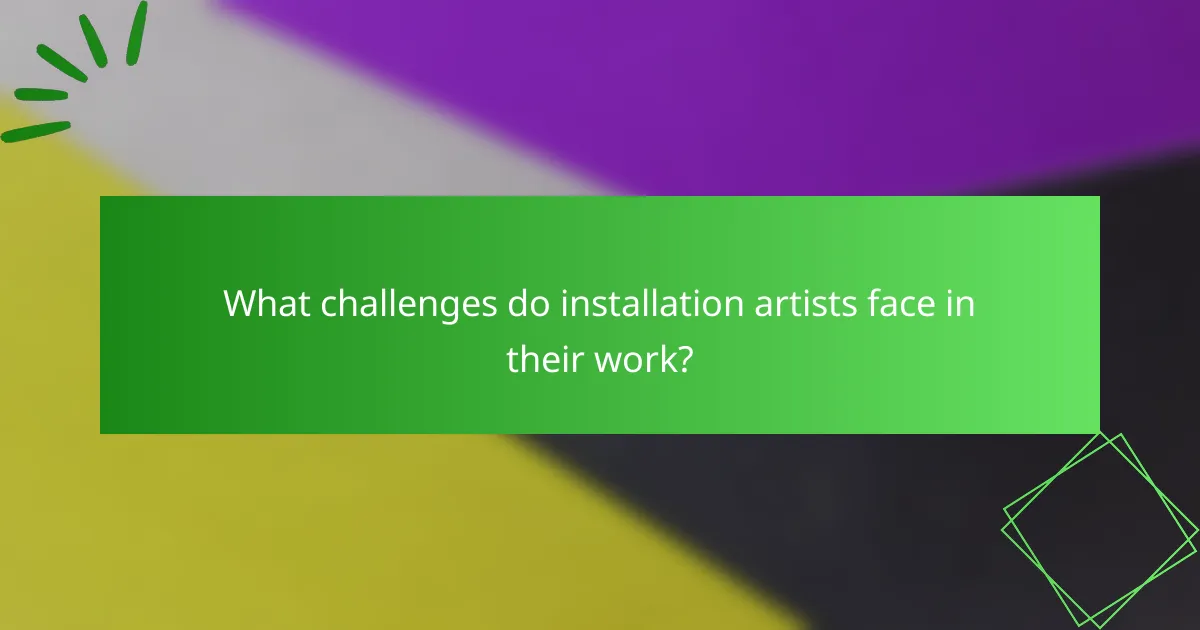
What challenges do installation artists face in their work?
Installation artists face various challenges, including funding, space limitations, and audience engagement. Limited budgets often constrain materials and resources. Finding suitable venues can be difficult, as installations require specific environments. Engaging audiences effectively is essential, yet challenging, as installation art often demands active participation and interpretation. Additionally, artists may confront logistical issues related to installation size and complexity.
How do logistical issues affect the execution of installations?
Logistical issues significantly hinder the execution of installations by causing delays and increasing costs. Factors such as transportation challenges, site accessibility, and coordination among artists and vendors can disrupt timelines. For instance, the complexity of assembling large-scale installations may require precise scheduling to ensure all components arrive on time. As a result, inadequate planning can lead to missed deadlines and compromised artistic vision.
What are the environmental considerations in installation art?
Environmental considerations in installation art include sustainability, material sourcing, and ecological impact. Artists often prioritize eco-friendly materials and practices to minimize harm. The use of local resources reduces transportation emissions, while biodegradable or recycled materials enhance sustainability. Additionally, installation art can raise awareness about environmental issues, prompting viewers to reflect on their relationship with nature.
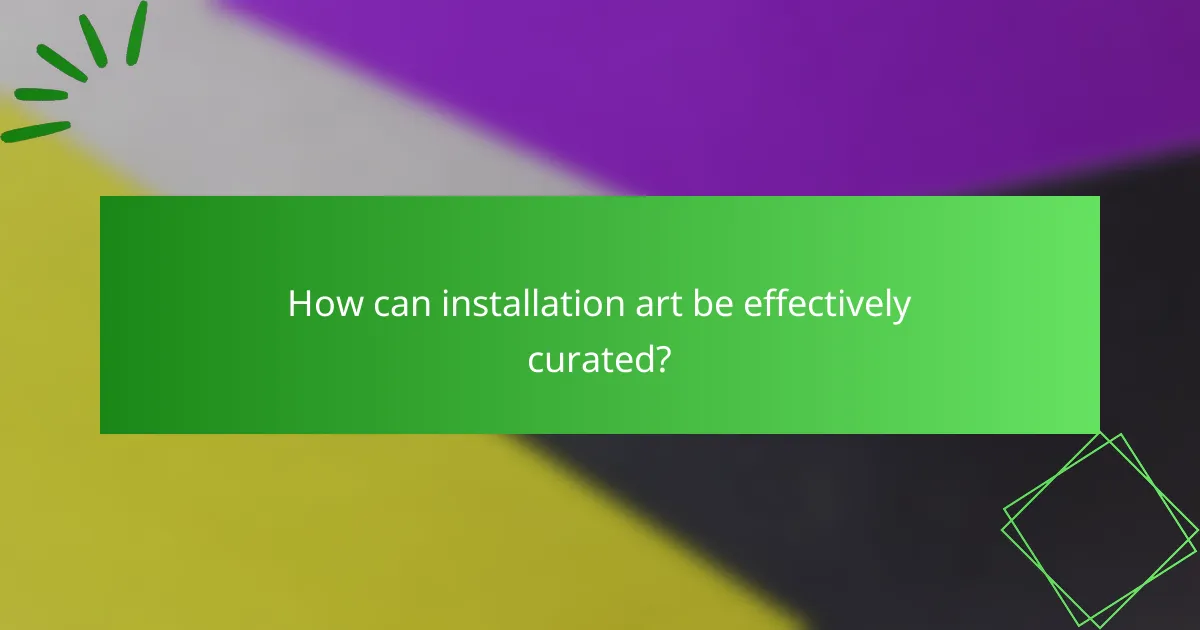
How can installation art be effectively curated?
Effective curation of installation art requires a clear vision, audience engagement, and contextual relevance. Curators should prioritize the narrative and emotional impact of installations. Selecting works that resonate with current social themes enhances viewer connection. Collaboration with artists fosters authenticity and innovation. Additionally, considering the spatial dynamics of the installation space influences the overall experience.
What strategies enhance visitor experience in installation exhibitions?
Engaging visitors in installation exhibitions enhances their overall experience. Strategies include interactive elements, guided tours, immersive storytelling, and sensory engagement.
Interactive elements invite participation, allowing visitors to connect with the artwork. Guided tours provide context and insights, enriching understanding. Immersive storytelling weaves narratives that resonate emotionally. Sensory engagement stimulates multiple senses, creating memorable encounters.
How do curatorial choices impact the interpretation of installations?
Curatorial choices significantly shape the interpretation of installations by guiding viewer perception and engagement. The selection of themes, materials, and spatial arrangements influences emotional responses and meanings. For example, a curator’s decision to emphasize certain elements can highlight social issues or artistic techniques, creating distinct narratives. This intentional framing can transform an installation from a simple display into a profound commentary, enhancing its impact on audiences.

What future trends are emerging in installation art?
Emerging trends in installation art include increased interactivity, integration of technology, and a focus on social issues. Artists are using virtual and augmented reality to enhance viewer engagement. Additionally, environmentally conscious installations are gaining traction, reflecting sustainability themes. Collaborative projects are also on the rise, fostering community involvement and dialogue. These trends signify a shift towards immersive, thought-provoking experiences that challenge traditional art boundaries.
How is technology reshaping installation art practices?
Technology is significantly transforming installation art practices by enhancing interactivity and immersive experiences. Digital tools allow artists to create dynamic environments that engage viewers on multiple sensory levels. For instance, virtual reality enables audiences to explore spaces in ways that traditional installations cannot. Additionally, projection mapping and augmented reality introduce new dimensions to artworks, making them more accessible and relatable. These advancements foster collaboration across disciplines, leading to innovative installations that challenge conventional perceptions of art.
What role do virtual and augmented realities play in installation art?
Virtual and augmented realities significantly enhance installation art by creating immersive experiences. These technologies allow artists to engage audiences through interactive elements that transcend traditional boundaries. For instance, augmented reality can overlay digital components onto physical installations, enriching the viewer’s experience. Additionally, virtual reality offers entirely new environments, enabling artists to explore concepts in ways that are not possible in the physical realm. This fusion of art and technology expands the impact of installation art, making it more accessible and engaging for diverse audiences.
What best practices should artists and curators follow in installation art?
Artists and curators should prioritize audience engagement, site-specificity, and conceptual clarity in installation art. Effective communication of the artwork’s message enhances viewer experience.
1. Engage the audience emotionally to create a memorable experience.
2. Consider the installation’s location to enhance relevance and impact.
3. Ensure the concept is clear and accessible to the audience.
4. Use diverse materials and techniques to enrich the visual experience.
5. Collaborate with other artists and curators to broaden perspectives.
6. Document the installation process and final outcome for future reference.
